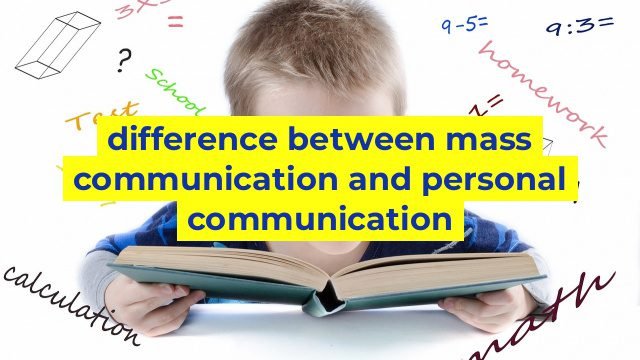The Fundamental Difference between Mass Communication and Personal Communication
When it comes to communication, people must understand that it can take place in various forms, depending on the context, the individuals involved and the mode of communication. The available forms of communication include mass communication and personal communication. Both serve various functions and ultimately differ in their scope and nature. In this article, we will explore the differences between mass communication and personal communication.
Meaning and Scope
Mass communication refers to the process of imparting information or messages to a large and diverse audience, using mass media channels like television, radio, newspapers, magazines, and the internet. The main objective of mass communication is to disseminate information or messages to a broad audience in the shortest amount of time, with the aim of influencing their attitudes and behaviors. The scope of mass communication is vast, and messages are generally intended for an extensive range of people.
On the other hand, personal communication refers to the exchange of information or messages between individuals, with the goal of establishing personal relationships or sharing personal information. Personal communication can be verbal, for instance, face-to-face conversations, or written such as emails, letters, and messages. Personal communication is an essential aspect of human interactions and makes up for a large part of our lives. The scope of personal communication is usually limited to a few individuals who know one another.
Communication Channels used
Mass communication employs a variety of mass media channels to reach out to large groups of audiences. Television, radio, newspapers, and magazines are the most common means of mass communication. The internet has also emerged as a vital tool for mass communication today. The use of digital technologies has enabled mass media channels to reach vast audiences across geographical boundaries.
Personal communication, on the other hand, is more informal and relies on verbal and written communication channels. Conversations and messages between individuals can be initiated via face to face talks, phone calls, text messages, and emails. The use of digital technologies has made personal communication much more accessible and convenient, allowing people to stay in touch with their loved ones across the world.
Control and Feedback
Mass communication is generally one-way communication, where the sender is the authority over the message, and the receiver is passive. Mass communication channels are designed to deliver messages to an extensive range of audience with minimal customization. Feedback from the audience is often delayed, indirect, and more challenging to obtain.
Personal communication, however, is more interactive than mass communication. Personal communication channels allow for a two-way flow of information, where the sender and receiver have equal control over the message. Personal communication channels also offer immediate feedback, response, and discussion, thus promoting a more engaging conversation.
In conclusion, mass communication and personal communication are both essential forms of communication in our daily lives. Mass communication ensures that the vast population is informed about various events happening across the globe, while personal communication has significant value in establishing and nurturing personal relationships. Understanding these differences is essential in utilizing the correct communication channels, depending on the context and purposes.
Table difference between mass communication and personal communication
| Aspect | Mass Communication | Personal Communication |
|---|---|---|
| Definition | The process of delivering information to a large group of people through mass media channels | The process of exchanging ideas, thoughts, and information between two or more individuals |
| Channels | Newspapers, television, radio, magazines, internet | Face-to-face conversations, phone calls, text messages, emails |
| Audience | Large, diverse, and dispersed audience | Small, specific, and localized audience |
| Message | Similar message delivered to a large audience | Personalized message tailored to the individual or group |
| Feedback | Limited or delayed feedback from the audience | Immediate feedback from the receiver |
| Control | Controlled by the source or sender | Shared control between the sender and receiver |


